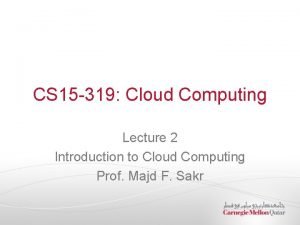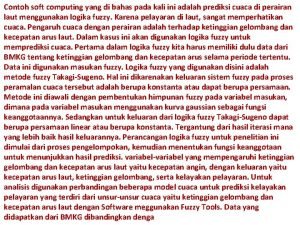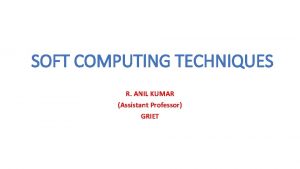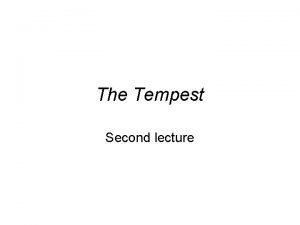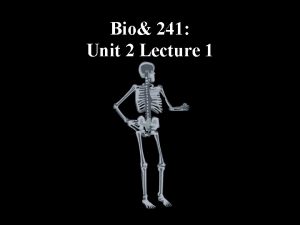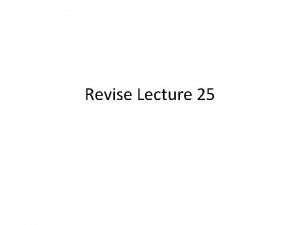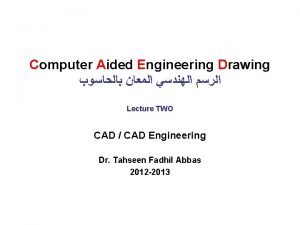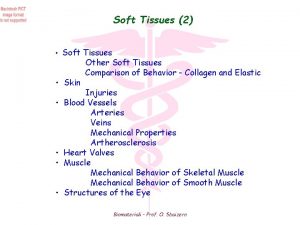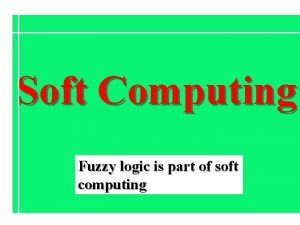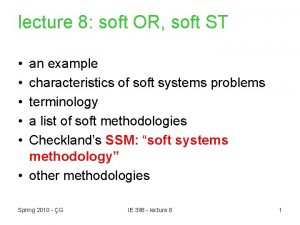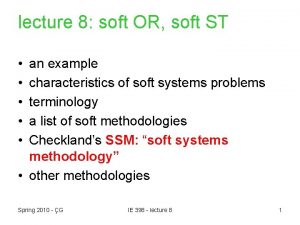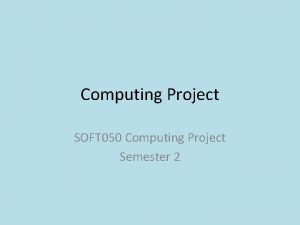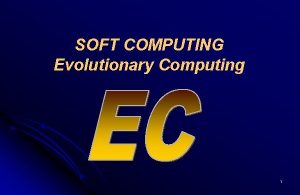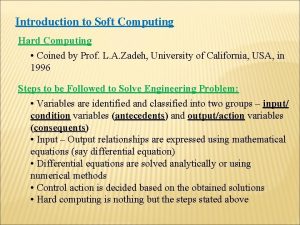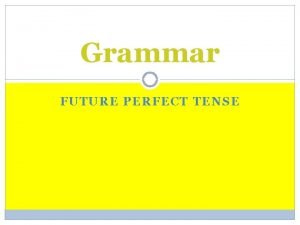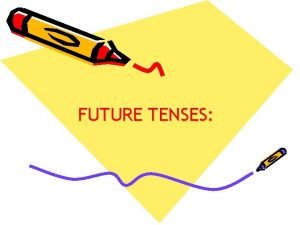Soft Computing Lecture 24 Future of soft computing





























- Slides: 29

Soft Computing Lecture 24 Future of soft computing. Introduction to generalized theory of uncertainty 19. 12. 2005

Directions of future development of soft computing • Development of Generalized Theory of Uncertainty of Zadeh and usage of it in knowledge engineering • Continue of usage of different neural networks in different areas and development of methods of combination and selection of ones • Development of universal model of neural network (may be based on spike neurons) • Development of hardware platform for neural networks • Development of quantum computing 19. 12. 2005 2

Main concepts of Generalized Theory of Uncertainty of Zadeh • Tradition to view uncertainty as a province of probability theory. This is incorrect. • Contrary to one L. Zadeh proposed Generalized Theory of Uncertainty (GTU) (2005) in which uncertainty is a important feature of information and fuzzy and probability are only methods of description of one • Uncertainty is an attribute of information. • The principal premise of GTU is that, fundamentally, information is a generalized constraint on the values which a variable is allowed to take. • The principal tools which GTU draws from fuzzy logic include Precisiated Natural Language (PNL) and Protoform Theory (PFT) 19. 12. 2005 3

Main concepts (2) • In GTU, uncertainty is linked to information through the concept of granular structure—a concept which plays a key role in human interaction with the real world (Zadeh) • A granule of a variable X is a clump of values of X which are drawn together by indistinguishability, equivalence, similarity, proximity or functionality. For example, an interval is a granule. So is a fuzzy interval. And so is a probability distribution. • Granulation is pervasive in human cognition. For example, the granules of Age are fuzzy sets labeled young, middle-aged and old. • The concept of granularity underlies the concept of a linguistic variable (Zadeh, 1973) 19. 12. 2005 4

Rationales for granulation of attributes • Four basic rationales which underlie granulation of attributes and the concomitant use of linguistic variables: – The bounded ability of sensory organs, and ultimately the brain, to resolve detail and store information (looking at Monika, I see that she is young but cannot pinpoint her age as a single number) – When numerical information may not be available (I may not know exactly how many Spanish restaurants there are in San Francisco, but my perception may be “not many”) – When an attribute is not quantifiable (we describe degrees of Honesty as: low, not high, very high, etc because we do not have a numerical scale) – When there is a tolerance for imprecision which can be exploited through granulation to achieve tractability, robustness and economy of communication (it may be sufficient to know that Monika is young; her exact age may be unimportant) 19. 12. 2005 5

Generalized constraints and probability • A basic question which arises is: How can the meaning of *a be precisiated? • In the context of standard probability theory, call it PT, *a would normally be interpreted as a probability distribution centering on a. • In GTU, information about X is viewed as a generalized constraint on X. More specifically, in the context of GTU, *a would be viewed as a granule which is characterized by a generalized constraint. • A probability distribution is a special case of a generalized constraint. In this sense, GTU is more general than PT. 19. 12. 2005 6

Rationales for GTU • Below is a demonstrable need for GTU because existing approaches to representation of uncertain information are inadequate for dealing with problems in which uncertain information is perception-based and is expressed in a natural language • The Robert example. Usually Robert returns from work at about 6: 00 pm. What is the probability that Robert is home at about 6: 15 pm? • The balls-in-box example. A box contains about twenty black and white balls. Most are black. There are several times as many black balls as white balls. What is the number of white balls? What is the probability that a ball drawn at random is white? • The tall Swedes problem. Most Swedes are tall. What is the average height of Swedes? How many Swedes are short? • The partial existence problem. X is a real-valued variable; a and b are real numbers, with a b. I am uncertain about the value of X. What I know about X is that (a) X is much larger than approximately a, *a; and (b) that X is much smaller than approximately b, *b. What is the value of X? • Vera’s age problem. Vera has a son who is in mid-twenties, and a daughter, who is in mid-thirties. What is Vera’s age? 19. 12. 2005 7

Two kinds of information 19. 12. 2005 8

Generalized constraint • GC: X isr R, – where X is the constrained variable; R is a constraining relation which, in general, is non-bivalent; and r is an indexing variable which identifies the modality of the constraint, that is, its semantics. • The constrained variable, X, may assume a variety of forms. In particular, • X is an n-ary variable, X=(X 1, …, Xn) • X is a proposition, e. g. , X=Leslie is tall • X is a function of another variable, X=f(Y) • X is conditioned on another variable, X/Y • X has a structure, e. g. , X=Location(Residence(Carol)) • X is a group variable. In this case, there is a group, G[A]; with each member of the group, Namei, i=1, …, n, associated with an attribute –value, Ai. Ai may be vector-valued. Symbolically • G[A]: Name 1/A 1+…+Namen/An. • Basically, G[A] is a relation. • X is a generalized constraint, X= Y isr R 19. 12. 2005 9

Principal modalities of generalized constraints • Possibilistic (r=blank) – – X is R with R playing the role of the possibility distribution of X. Examples: • • • X is [a, b]: X is small. Probabilistic (r=p) – – X isp R, with R playing the role of the probability distribution of X. Examples: • • • X isp N(m, 2) X isp (p 1 u 1+…+ pn un) Veristic – – • • 19. 12. 2005 (r=v) X isv R, where R plays the role of a verity (truth) distribution of X. In particular, if X takes values in a finite set {u 1, …, un} with respective verity (truth) values t 1, …, tn, then X may be expressed as X isv (t 1|u 1+ …+tn|un) if Robert is half German, quarter French and quarter Italian, then Ethnicity(Robert) isv 0. 5|German+0. 25|French+0. 25|Italian 10

Principal modalities of generalized constraints (2) • Usuality (r=u) – X isu R. – The usuality constraint presupposes that X is a random variable, and that the probability of the event {X isu R} is usually, where usually plays the role of a fuzzy probability which is a fuzzy number. Example: – X isu small means that “usually X is small” • Random-set constraint – (r=vs) – In X isrs R, X is a fuzzy-set-valued random variable and R is a fuzzy random set • Fuzzy-graph constraint – (r=fq) – In X isfg R, X is a function, f, and R is a fuzzy graph (Zadeh) which constrains f. A fuzzy graph is a disjunction of Cartesian granules expressed as R=A 1 B 1+…+An Bn, where the Ai and B 1, i=1, …, n, are fuzzy subsets of the real line, and is the Cartesian product. – A fuzzy graph is frequently described as a collection of fuzzy if-then rules: • R: if X is Aj then Y is Bj, 19. 12. 2005 i=1, …, n 11

Principal modalities of generalized constraints (3) • Bimodal (r=bm) – In the bimodal constraint, X isbm R, R is a bimodal distribution of the form • R: i PiAi , i=1, …, n. • which means that Prob(X is Ai) is Pi. Example: • R: lowsmall+highmedium+lowlarge • Group (r=g) – In X isg R, X is a group variable, G[A], and R is a group constraint on G[A]. More specifically, if X is a group variable of the form • G[A]: Name 1/Ai +…+ Namen/An 19. 12. 2005 12

Primary constraints • The three primary constraints—possibilistic, probabilistic and veristic—are closely related to a concept which has a position of centrality in human cognition—the concept of partiality. In the sense used here, partial means: a matter of degree or, more or less equivalently, fuzzy. In this sense, almost all human concepts are partial (fuzzy). • Familiar examples of fuzzy concepts are: knowledge, understanding, friendship, love, beauty, intelligence, belief, causality, relevance, honesty, mountain and, most important, truth, likelihood and possibility. 19. 12. 2005 13

Operations on generalized constraints • Conjunction In this example, if S is a fuzzy relation then T is a fuzzy random set. 19. 12. 2005 14

Operations on generalized constraints (2) • Projection (possibilistic) 19. 12. 2005 15

Operations on generalized constraints (3) • Projection 19. 12. 2005 (probabilistic) 16

Operations on generalized constraints (4) • Propagation where f and g are functions or functionals. where R and S are fuzzy sets. 19. 12. 2005 17

Generalized Constraint Language • A concept which plays an important role in GTU is that of Generalized Constraint Language (GCL). Informally, GCL is the set of all generalized constraints together with the rules governing syntax, semantics and generation. Simple examples of elements of GCL are: – ((X, Y) isp A) (X is B) – (X isp A) ((X, Y) isv B) – Proj. Y((X is A) (X, Y) isp B) • where is conjunction. • A very simple example of a semantic rule is: – (X is A) (Y is B) -> Poss(X=u, Y=v) = A(u) B(v), where u and v are generic values of X, Y, and A and B are the membership functions of A and B, respectively. 19. 12. 2005 18

The Concept of Precisiation and PNL • A key idea which underlies the concept of Precisiated Natural Language (PNL), is to represent the meaning of p as a generalized constraint, in symbols. 19. 12. 2005 19

Translation of proposition to GCL 19. 12. 2005 20

Precisiation/Imprecisiation Principle (P/I Principle) • Informally, let f be a function or a functional Y=f(X), where X and Y are assumed to be imprecise, Pr(X) and Pr(Y) are precisiations of X and Y, and *Pr(X) and *Pr(Y) are imprecisiations of Pr(X) and Pr(Y), respectively. • In symbolic form, the P/I Principle may be expressed as f(X)*=*f(Pr(X)) where *= denotes “approximately equal, ” and *f is imprecisiation of f. In words, to compute f(X) when X is imprecise, (a) precisiate X, (b) compute f(Pr(X)); (c) imprecisiation f(Pr(X)). Then, usually, *f(Pr(X)) will be approximately equal to f(X). An underlying assumption is that approximation, are commensurate in the sense that the closer Pr(X) is to X, the closer f(Pr(X)) is to f(X). 19. 12. 2005 21

Precisiation/Imprecisiation Principle (P/I Principle) (2) • As an illustration, suppose that X is a real-valued function; f is the operation of differentiation, and *X is the fuzzy graph of X. Then, using the P/I Principle, *f(X) will have the form shown in Fig. It should be underscored that imprecisiation is an imprecise concept. 19. 12. 2005 22

Illustration of precisiation of propositions and questions • The Robert example – p: Usually Robert returns from work at about 6 pm. – q: What is the probability that Robert is home at about 6: 15 pm? • Precisiation of p may be expressed as – p: Prob(Time(Return(Robert)) is *6: 00 pm) is usually where “usually” is a fuzzy probability • Precisiation of q may be expressed as – q: Prob(Time(Return(Robert)) is 6: 15 pm) is A? where is the operation of composition, and A is a fuzzy probability 19. 12. 2005 23

Reasoning • Reasoning under uncertainty has many facets. The facet that is the primary focus of attention in GTU is reasoning with, or equivalently, deduction from, uncertain information expressed in a natural language. • Precisiation is a prelude to deduction. In this context, deduction in GTU involves, for the most part, computation with precisiations of propositions drawn from a natural language. A concept which plays a key role in deduction is that of a protoform—abbreviation of “prototypical form” (Zadeh). 19. 12. 2005 24

Protoforms • Informally, a protoform of an object is its abstracted summary. More specifically, a protoform is a symbolic expression which defines the deep semantic structure of an object such as a proposition, question, command, concept, scenario, case or a system of such objects. In the following, our attention which will be focused on protoforms of propositions, with PF(p) denoting a protoform of p. 19. 12. 2005 25

Protoforms (2) • Abstraction has levels, just as summarization does. For this reason, an object may have a multiplicity of protoforms (Fig. 16). Conversely, many objects may have the same protoform. Such objects are said to be protoform-equivalent, or PF-equivalent, for short. • The set of protoforms of all precisiable propositions in NL, together with rules which govern propagation of generalized constraints, constitute what is called the Protoform Language (PFL). 19. 12. 2005 26

Examples of protoforms 19. 12. 2005 27

Protoformal deduction • The rules of deduction in GTU are, basically, the rules which govern constraint propagation. In GTU, such rules reside in the Deduction Database (DDB) • The Deduction Database comprises a collection of agent-controlled modules and submodules, each of which contains rules drawn from various fields and various modalities of generalized constraints. 19. 12. 2005 28

Extension principle Note: The extension principle is a primary deduction rule in the sense that many other deduction rules are derivable from the extension principle. 19. 12. 2005 29
 Future perfect future continuous exercises
Future perfect future continuous exercises Future perfect simple vs future perfect continuous
Future perfect simple vs future perfect continuous 01:640:244 lecture notes - lecture 15: plat, idah, farad
01:640:244 lecture notes - lecture 15: plat, idah, farad Cloud computing lecture
Cloud computing lecture Cmu cloud computing
Cmu cloud computing Contoh soft computing
Contoh soft computing Soft computing techniques
Soft computing techniques What is fuzzification in soft computing
What is fuzzification in soft computing Future continuous in the past tense
Future continuous in the past tense Nulti i prvi kondicional
Nulti i prvi kondicional Future tense of work
Future tense of work How to use present continuous for future
How to use present continuous for future Future continuous future perfect exercises
Future continuous future perfect exercises Future plans and finished future actions
Future plans and finished future actions Summary of past and present
Summary of past and present Future nurse future midwife
Future nurse future midwife Future continuous vs future perfect
Future continuous vs future perfect Future perfect presentation
Future perfect presentation Conventional computing and intelligent computing
Conventional computing and intelligent computing Sensitivity analysis lecture notes
Sensitivity analysis lecture notes Om306
Om306 Electricity and magnetism lecture notes
Electricity and magnetism lecture notes Orf in bioinformatics
Orf in bioinformatics Prospero
Prospero Introduction to psychology lecture
Introduction to psychology lecture Bone tuberosity
Bone tuberosity Project management lecture notes doc
Project management lecture notes doc What are the features of a cheque
What are the features of a cheque Drawing lecture
Drawing lecture Trois femmes puissantes lecture cursive
Trois femmes puissantes lecture cursive




